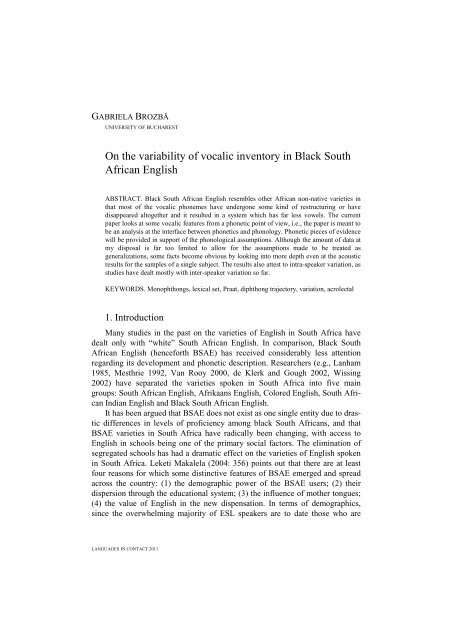s - Wyższa SzkoÅa Filologiczna we WrocÅawiu
s - Wyższa SzkoÅa Filologiczna we WrocÅawiu
s - Wyższa SzkoÅa Filologiczna we WrocÅawiu
Create successful ePaper yourself
Turn your PDF publications into a flip-book with our unique Google optimized e-Paper software.
GABRIELA BROZBĂ<br />
UNIVERSITY OF BUCHAREST<br />
On the variability of vocalic inventory in Black South<br />
African English<br />
ABSTRACT. Black South African English resembles other African non-native varieties in<br />
that most of the vocalic phonemes have undergone some kind of restructuring or have<br />
disappeared altogether and it resulted in a system which has far less vo<strong>we</strong>ls. The current<br />
paper looks at some vocalic features from a phonetic point of view, i.e., the paper is meant to<br />
be an analysis at the interface bet<strong>we</strong>en phonetics and phonology. Phonetic pieces of evidence<br />
will be provided in support of the phonological assumptions. Although the amount of data at<br />
my disposal is far too limited to allow for the assumptions made to be treated as<br />
generalizations, some facts become obvious by looking into more depth even at the acoustic<br />
results for the samples of a single subject. The results also attest to intra-speaker variation, as<br />
studies have dealt mostly with inter-speaker variation so far.<br />
KEYWORDS. Monophthongs, lexical set, Praat, diphthong trajectory, variation, acrolectal<br />
1. Introduction<br />
Many studies in the past on the varieties of English in South Africa have<br />
dealt only with “white” South African English. In comparison, Black South<br />
African English (henceforth BSAE) has received considerably less attention<br />
regarding its development and phonetic description. Researchers (e.g., Lanham<br />
1985, Mesthrie 1992, Van Rooy 2000, de Klerk and Gough 2002, Wissing<br />
2002) have separated the varieties spoken in South Africa into five main<br />
groups: South African English, Afrikaans English, Colored English, South African<br />
Indian English and Black South African English.<br />
It has been argued that BSAE does not exist as one single entity due to drastic<br />
differences in levels of proficiency among black South Africans, and that<br />
BSAE varieties in South Africa have radically been changing, with access to<br />
English in schools being one of the primary social factors. The elimination of<br />
segregated schools has had a dramatic effect on the varieties of English spoken<br />
in South Africa. Leketi Makalela (2004: 356) points out that there are at least<br />
four reasons for which some distinctive features of BSAE emerged and spread<br />
across the country: (1) the demographic po<strong>we</strong>r of the BSAE users; (2) their<br />
dispersion through the educational system; (3) the influence of mother tongues;<br />
(4) the value of English in the new dispensation. In terms of demographics,<br />
since the overwhelming majority of ESL speakers are to date those who are<br />
LANGUAGES IN CONTACT 2011
















